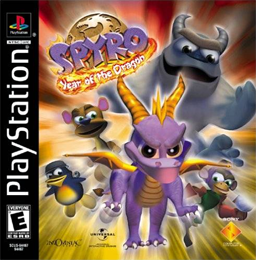Spyro: Year of the Dragon
| Spyro: Year of the Dragon | |
|---|---|

North American cover art
|
|
| Developer(s) | Insomniac Games |
| Publisher(s) | Sony Computer Entertainment |
| Distributor(s) | Universal Interactive Studios |
| Director(s) | Connie Booth |
| Producer(s) | Donovan Soto Grady Hunt |
| Composer(s) |
Stewart Copeland Ryan Beveridge |
| Series | Spyro |
| Platform(s) | PlayStation |
| Release date(s) | October 10, 2000 |
| Genre(s) | Platformer |
| Mode(s) | Single-player |
| Aggregate scores | |
|---|---|
| Aggregator | Score |
| GameRankings | 91% |
| Metacritic | 91/100 |
| Review scores | |
| Publication | Score |
| AllGame | |
| Game Revolution | A- |
| GameSpot | 8.1/10 |
| IGN | 9.1/10 |
Spyro: Year of the Dragon is a platform video game developed by Insomniac Games and published by Sony Computer Entertainment for the PlayStation in 2000. Year of the Dragon is the third installment in the Spyro series and the last Spyro game to be released for the first generation PlayStation. The game was also the last Spyro game Insomniac developed; their next title would be Ratchet & Clank for the PlayStation 2.
Named after the animal of the Chinese zodiac, which was the symbol at the time of the game's release, Year of the Dragon follows the titular purple dragon Spyro as he travels to the "Forgotten Worlds" after 150 magical dragon eggs are stolen from the land of the dragons by an evil sorceress. Players travel across thirty different worlds gathering gems and eggs. Year of the Dragon introduced new characters and minigames to the series, as well as offering improved graphics and music.
Upon release, the game sold more than two million units in the United States and received positive critical response. Reviewers noted the game built on the successful formula of its predecessors by adding more games and expansive environments. It was followed by the multiplatform title Spyro: Enter the Dragonfly.
Year of the Dragon is set primarily in the third-person; its gameplay makes few deviations from that of its predecessors. The main objective of the game is to collect special dragon eggs which are scattered across 37 worlds. These eggs are hidden, or are given as rewards for completing certain tasks and levels. The worlds of Spyro are linked together by "homeworlds" or "hubs", large worlds which contain gateways to many other levels. To proceed to the next hub, the character must complete five worlds, gather a certain number of eggs, and defeat a boss. Players do not need to gather every egg to complete the main portion of the game or gain access to new levels; in fact, certain eggs can only be found by returning to the world at a later time. Gems are scattered across the worlds, hidden in crates and jars. These gems are used to bribe a bear named Moneybags to release captured "critters" and activate things which help Spyro progress through levels (Such as bridges). Gems, along with the number of eggs collected, count to the total completion percentage of the game.
...
Wikipedia
